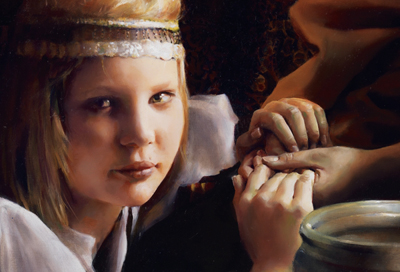Paint What You See
By Elspeth C. Young
Recently, a gentleman approached me at the conclusion of an art lecture, and eagerly asked me this singular question: "When you paint faces, do you paint the opposite color of the highlight in the shadow area?"
 |
| Detail from The Trial of Faith, an oil painting by Elspeth Young |
"Oh, then you paint what you see," he said, looking almost as though I had given him some master studio secret. "Yes!" I replied, even more puzzled.
His query, though really quite an innocent one, has caused me much reflection since then. "Paint it like you see it" has been our Studio motto for such a long time that I tend to forget my student-days when I craved artistic "formulas," to help me in my quest for style and technique. It was as though I thought becoming an artist was simply a matter of memorizing some master list of What-To-Do-In-Any-Difficult-Painting-Senario—a group of artistic recipes known only by the pros. In my student strivings, I drank in any instructor's "idioms" for never-fail-techniques, and adopted such shortcuts as often as possible, believing that they were the only legitimate way to communicate line and color.
Blessedly, my greatest mentor—my father—as well as two painting professors in my college days, did not demand a certain technique from their students. They were not anxious to churn out protégés who mechanically painted by a list of rules—"paint highlights warm and shadows cold," etc. Instead, they expected their students to visually dissect and analyze the world around then, and then to become painters by personal trial and error, not by rote formula. The ability these masters instilled in me—to discern the beautiful and then to communicate it with a brush stroke (no matter how long it took to obtain the desired result)—became my own "formula" for success, and it's the only one I know which never fails.
I believe that one of the greatest misconceptions about artists is that "it's all in the tricks and techniques." Actually, it's all in the eyes. The ability to see is paramount. The actual techniques used to communicate what an artist sees is only secondary, and, I find, comes naturally once the artist has "looked" long enough.
So, in a world influenced by paint-by-number, art kits of every kind, and countless polar theories on the very best (or only!) methods and techniques best for the budding artist, perhaps it really is a "master studio secret" to simply paint what you see.
Browse articles by year: 2025 . 2024 . 2023 . 2022 . 2021 . 2020 . 2019 . 2018 . 2017 . 2016 . 2015 . 2014 . 2013 . 2012 . 2011 . 2010 . 2009 . 2008 . 2007 . 2006 . 2005 . 2004 . 2003 . 2002 . 2001 . 2000 . 1999 . 1998 . 1997 . 1996
Browse articles by topic: Art lessons . BenHaven Archives . Blank art diaries . Fine art photography . Framing . Illustration . Inspiration and creativity . Isles of Rune . Limited Editions Collection . My Fathers Captivity . News . Novellas . Oil paintings and prints . Operations announcements . Orders and shipping . Overview . Portfolios . The Papers of Seymore Wainscott . Project commentaries . Recipes by Nancy Young . Recommended reading . Recommended viewing . Temple artworks . The Storybook Home Journal . Tips and techniques . Tools supplies and operations
Browse articles by topic: Art lessons . BenHaven Archives . Blank art diaries . Fine art photography . Framing . Illustration . Inspiration and creativity . Isles of Rune . Limited Editions Collection . My Fathers Captivity . News . Novellas . Oil paintings and prints . Operations announcements . Orders and shipping . Overview . Portfolios . The Papers of Seymore Wainscott . Project commentaries . Recipes by Nancy Young . Recommended reading . Recommended viewing . Temple artworks . The Storybook Home Journal . Tips and techniques . Tools supplies and operations